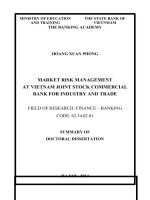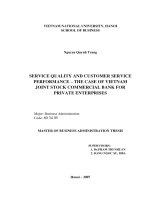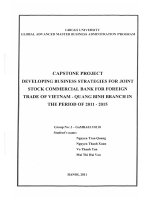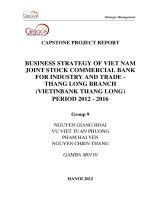Situation, solutions to improve the efficiency of credit operation to SMEs in the sai gon joint stock commercial bank (SCB)
Bạn đang xem bản rút gọn của tài liệu. Xem và tải ngay bản đầy đủ của tài liệu tại đây (393.92 KB, 79 trang )
1
Graduation Thesis
DECLARATION
Signed hereby, certify hereby that this is my own research. The content and
the figures presented in the thesis reflected a fair and true situation of the
internship organization.
Ha Noi, May 9th, 2016
Student
Pham Thi Thuy Hang
Pham Thi Thuy Hang
CQ50/51.02
2
Graduation Thesis
ABSTRACT
This thesis is aimed at studying situation and solutions to improve the
efficiency of credit operation to SMEs in Sai Gon Joint Stock Commercial
Bank (SCB), Hong Bang branch, Hai Phong city from 2012 to 2014. This
thesis was clearly analyzed through using the following methodology:
comparing, statistics, analysis, synthesis, description, etc. All data were
collected from the financial statement, income statement, annual reports of
SCB – Hong Bang branch from 2012 to 2014. It can be said that the branch
has gained some achievements in improving the efficiency of credit operation
through facilitating loans to SMEs in the period of economic crisis, success in
controlling bad debts and overdue loans and implementing some appropriate
strategies about the structure of banks' loans and loan security. However, there
are still shortcomings including low loan sales to SMEs, low outstanding
loans to SMEs, unprofessional in lending procedures, only focusing on loans
to SMEs in the short term. From the results, some proposals were given to the
Government, the State Bank of Viet Nam, SMEs and SCB's headquarter.
Hopefully, this thesis will provide general support for SCB–Hong Bang
branch, Hai Phong city to have a better result in credit operation to SMEs in
the near future.
Pham Thi Thuy Hang
CQ50/51.02
3
Graduation Thesis
ACKNOWLEGEMENTS
To fulfill this thesis, I would like to give my special thanks to many people for
their significant helps, contributions, recommendations and encouragement
during my writing process.
Firstly and foremost, I would like to give my heartfelt thanks to Ms Pham
Phuong Oanh, my supervisor who has provided me the valuable support,
practical insights and helpful feedback from the beginning of forming thesis’s
topic until the completion.
Secondly, I also express profound gratitude to all staffs of SCB – Hong Bang
branch, Hai Phong city, credit department and especially Mr Do Thanh Trung,
my instructor for his enthusiastic instructions and useful data that he gave to
me.
In addition, I highly appreciated indirect support from Finance - Accounting
Department staffs, who gave me a straightway instruction, reminded me of
the internship schedule, supported reference documents, and were always
available anytime for help.
Finally, I owe my sincere thanks to my family and friends. Their continuous
assistance and encouragement helped me a lot during time of internship and
attempt to finish this study.
Pham Thi Thuy Hang
CQ50/51.02
4
Graduation Thesis
TABLE OF CONTENTS
LIST OF ABBREVIATIONS
AOF
Academy Of Finance
EBT
Earnings Before Tax
ECU
European Currency Unit
ESAF
Enhanced Structural Adjustment Facility
EU
European
GDP
Gross Domestic Product
GSO
General Statistic Office
JPY
Japanese Yen
No
Number
ODA
Official Development Assistant
SCB
Sai Gon Joint Stock Commercial Bank
SISME
Science Institution of Small and Medium - sized
Enterprise
SMEs
Small and Medium - sized Enterprises
US
United States
VND
Viet Nam Dong
Pham Thi Thuy Hang
CQ50/51.02
5
Graduation Thesis
LIST OF FIGURES AND TABLES
Figure 1: Organizational structure of SCB, Hong Bang branch, Hai Phong
Pham Thi Thuy Hang
CQ50/51.02
6
Graduation Thesis
INTRODUCTION
1, Rationale of study
Small and medium – sized enterprises (SMEs) play an important role for Viet
Nam's economy, especially in the period of industrialization, modernization as
well as international economic integration. The fact shows that SMEs have
contributed nearly 40 percent of GDP and 50 percent of jobs for the society.
Therefore, this type of enterprises receives a lot of interest and support from
the government. It is confirmed that the bank credit greatly contributes to the
success of SMEs. The reason is that commercial banks are considered as a
funding channel of national and global economy. They are very important
position in financial intermediation system. In commercial banks, lending
activity is one of the most basic and practical activity. However, commercial
banks are cautious when deciding to make loans to SMEs because this type of
enterprises has potential risks affecting the continuity of business operation of
the banks and leads to the loss of banks' solvency now. As a result, SMEs are
difficult to access to capital of commercial banks and not many chances to
innovate technology. It causes that the credit operation to SMEs of
commercial banks is limited. Commercial banks in general and Sai Gon Joint
Stock Commercial Bank (SCB), Hong Bang branch, Hai Phong city in
particular also make efforts to enhance the quality of credit to SMEs, but in
fact, these banks only focus on loans to SMEs in the short term with high
interest rates to limit risks, give complex loan procedures and resolutely say
no to customers who do not meet the lending conditions. As a result, it
significantly affects commercial banks' profits and SMEs miss investment
opportunities. Clearly, improving the efficiency of credit operation to SMEs is
very important. Based on this viewpoint and current situation of credit
Pham Thi Thuy Hang
CQ50/51.02
7
Graduation Thesis
operation to SMEs in SCB, Hong Bang branch, Hai Phong city, I chose the
topic: "Situation, solutions to improve the efficiency of credit operation to
SMEs in the Sai Gon Joint Stock Commercial Bank (SCB), Hong Bang
branch, Hai Phong city" to study.
2, Aims of the study
The study focused on the efficiency of credit operation to SMEs and solutions
to improve the efficiency of credit operation to SMEs in SCB, Hong Bang
branch, Hai Phong city. The research aimed at three main purposes. Firstly,
the thesis gave theoretical background about credit operation efficiency to
SMEs in commercial banks. Secondly, the thesis analyzed and evaluated
current situation of credit operation to SMEs in SCB, Hong Bang, Hai Phong
city. Finally, the thesis gave solutions and recommendations to improve the
efficiency of credit operation to SMEs in SCB, Hong Bang branch, Hai Phong
city.
3, Scope of study
Studying the issues that clearly reflect the efficiency of credit operation to
SMEs including the process of granting credit to SMEs, credit products and
services to SMEs, the current situation of lending activity to SMEs, debt
collection to SMEs, bad debts and overdue loans to SMEs of SCB, Hong
Bang branch, Hai Phong city in the period of 2012-2014. From that, giving
solutions to improve the efficiency of credit operation to SMEs in the branch.
4, Methodology
To achieve the purpose of research, the thesis used some instruments as
follow:
The first is data analysis method. Specially, the thesis analyzed the situation
Pham Thi Thuy Hang
CQ50/51.02
8
Graduation Thesis
of credit operation to SMEs in the branch through comparing data in the
period of 2012-2014 to show the growth of credit operation to SMEs. Besides,
the thesis also used financial ratios to evaluate the efficiency of credit
operation to SMEs in the branch.
The second is comparing method. The thesis compared standards of SMEs
between some countries and Viet Nam, SMEs situation between Hai Phong
and Viet Nam and the credit operation between theory and practice in order to
improve the persuasiveness of thesis and gave reasonable solutions.
The third is statistical and descriptive method. The purpose of these methods
is to measure, describe, present data, and then give conclusions from the data.
With these methods, current credit situation to SMEs in the branch clearly
pointed
The fourth is synthetic method through analyzing rationale of study in chapter
1 and data in chapter 2.
5, Organization of the study
Besides introduction and conclusion, the thesis is divided into three main
chapters as following:
Chapter 1: Rationale of credit operation efficiency to small and medium –
sized enterprises in commercial banks.
Chapter 2: Current situation of credit operation for small and medium – sized
enterprises in Sai Gon Joint Stock Commercial Bank, Hong Bang branch, Hai
Phong city.
Chapter 3: Solutions and recommendations to improve credit operation
efficiency for small and medium – sized enterprises in Sai Gon Joint Stock
Commercial Bank, Hong Bang branch, Hai Phong city.
Pham Thi Thuy Hang
CQ50/51.02
9
Graduation Thesis
CHAPTER 1
LITERATURE REVIEW
1.1. Commercial banks
1.1.1. Definition
Commercial banks have considered as circulation system of capital to the
national and global economies. Their main activity is to mobilize the
temporarily idle funds in the economy and provide for the people who need
money in order to ensure continuous business process and make profit.
Discussing the concept of commercial banks, each country has its own
definition. For example, according to the Danish banking law in 1930,
commercial banks are essential banks including deposit operations, trading
in gold and silver, practicing commercial or real estate fields, credit facilities
and the draft to transfer funds and insure. According to US's assertion,
commercial banks are companies specializing in providing financial services
and operating in financial service industry.
In Vietnam, according to Decree No 59/2009/ND - CP dated on July 16, 2009
by Government about the organization and operation of commercial banks, a
commercial bank is a bank performing all bank activities and other business
activities so as to make profit under the provisions of the Credit Institutions
Law and other provisions of law.
From above three definitions, it is confirmed that all commercial banks have
three main features. Firstly, commercial banks accept deposits with the
responsibility to repay. Secondly, commercial banks use deposits to make
loans, invest and discount. Finally, these banks implement payments and
Pham Thi Thuy Hang
CQ50/51.02
10
Graduation Thesis
provide services to their clients.
1.1.2. Basic activities of commercial banks.
In consonance with Article 4, Section 12 of Credit Institutions Law dated on
June 16, 2010 by the XII National Assembly, banking operation is the
business and the regular supply of one or more transactions as follow:
a) Acceptance of deposits;
b) Granting credit,
c) Providing payment services through accounts.
Nowadays, bank activity makes significant progress; however, it still contains
three main activities. According to Mr Pham Ngoc Dung and Dinh Xuan
Hang, 2011 in Finance and currency, commercial banks' activities includes:
1.1.2.1. Capital mobilization activity of commercial banks
It is a basic operation and affects the quality of the banking operation.
Commercial banks raise capital from the following sources:
The first source is bank owners. Capital consists of authorized capital,
reserved funds and other debt assets under the regulations of central bank. It
is a decisive factor and life preserver for banks' business scale, especially as
banks faced the loss of solvency and bankruptcy.
The second source is economic entities. This is the most important capital
source reflecting the banks' nature "borrow money to lend money". The
capital was mainly formed through payment deposits and known as current
account, termed deposits, savings deposits
The third source is borrowing. Commercial banks can borrow from the central
bank or other credit institutions in domestic and foreign.
The last is other sources. Commercial banks can raise capital from other
sources such as support capital, investment and development capital,
investment trust funds to lend under the program or construction project,
Pham Thi Thuy Hang
CQ50/51.02
11
Graduation Thesis
deposits of other banks, etc.
1.1.2.2. Asset specialization - using funds
Asset specialization- using funds involves using the capital raised from debt
asset specialization. It includes three main activities. They are lending
activity, investment, joint venture capital contribution and budgetary
operation.
The first activity is lending. Lending operation is the most important activity
of commercial banks. This activity provides variety of loan types to
customers:
●
Short - term loan is the type of loan with less - than- one - year terms and
high lending turnover. This type is necessary for the business to offset the
shortage of working capital of businesses as well as capital demand of
individuals in short term.
●
Medium - term loan is the type of loan with one - year to five - year terms.
These loans are useful to investing and purchasing fixed assets, improving or
renovating equipment and expanding production
● Long - term loan is the type of loan with a term of more than five years or a
maximum term of 20-30 years, even 40 years. It is used to finance capital for
construction, transportation, programs and projects of socio-economic
development with large scales.
In table 1, the nature of each type of loan is indicated:
Pham Thi Thuy Hang
CQ50/51.02
12
Graduation Thesis
Table 1: Types of loans in commercial banks
Targets
Term
Short-term
≤ 1 year
Medium-term
1 year < loans ≤
Long-term
≥ 5 years
5 years
Loan
offset the
invest and purchase
finance capital for
purpose
shortage of
fixed assets, improve,
construction,
working capital
renovate equipment
transportation,
and expand
programs and projects
production
of socio-economic
development with the
large-scale
Interest
low
high
highest
Liquidity high
low
lowest
Risk
high
highest
low
The second activity is securities investment. Commercial banks play the role
as investors and sponsors to help businesses invest securities. Commercial
banks make profits through yield securities and stock market price differences
on the market.
The third activity is joint venture capital contribution. Commercial banks
invest an amount of capital to associate with other commercial banks, credit
institutions and enterprises in the field of production, trade and services with
determination to increase equity participation and create competitive position
on the market.
The last activity is budgetary operation. This activity contains cash reserve
demand so as to pay for clients, deposits in other banks and deposits in the
central bank. Although it doesn't directly create profit, it plays an extremely
important role in the process of payment for clients, liquidity risk reduction.
Pham Thi Thuy Hang
CQ50/51.02
13
Graduation Thesis
1.1.2.3. Service operation of commercial banks
Apart from credit activities, commercial banks also constantly improve
services such as payment services, guarantee, foreign currency, trust fund
activities, information activities, consultancy to earn additional income.
1.1.3. Bank credit
1.1.3.1. Definition
There are many definitions of bank credit.
For example, credit is a property transaction between borrowers and lenders
on the basis of borrowers' repayment promise in the future.
Another definition is that credit is a contractual agreement in which a
borrower receives something of value now and agrees to repay the lender at
some date in the future, generally with interest
However, we will have a full and brief definition in finance and currency
textbook of AOF Press. According to Mr Pham Ngoc Dung and Dinh Xuan
Hang, 2011 in Finance and currency, credit is the credit relationship between
lenders and borrowers based on the principle of repayment.
From the above definition, bank credit defined as the credit relationship
between banks and economic entities (businesses, individuals, organizations)
in the national economy based on the principle of repayment.
1.1.3.2. The nature of bank credit
Bank credit has four principal characteristics:
The first nature is that bank credit is a transaction between banks and
borrowers based on equity and mutual benefit.
The second nature is that the form of loans is currency which is temporarily
transferred from banks to borrowers. Nevertheless, banks only exchange the
right to use loans rather than ownership.
The third nature is that borrowers must be responsible for paying both
Pham Thi Thuy Hang
CQ50/51.02
14
Graduation Thesis
principal and interest for banks after exploiting the value of loans at a
prescribed time. This characteristic reflects the nature of credit movement to
be distinguished from other economic categories.
The last nature is belief. Credit is belief that is reflected through its name. The
confidence is built from both commercial banks and borrowers.
1.1.3.3. Characteristics of bank credit
Bank credit has following characteristics:
First, capital mobilization activity and lending of commercial banks mainly
conduct in the form of currency.
Next, commercial banks are intermediary credit institutions. When borrowing
from the public, commercial banks implement different methods. After that,
demands for capital of borrowers are satisfied by means of granting credit
with loan account or combination of accounts for loans and deposits, etc.
Besides, the process of movement and development of bank credit is in
relative independence with the process of social reproduction movement and
development.
Finally, bank credit accelerates the process of concentration and
harmonization of capital among entities in the economy because commercial
banks can solve supply and demand relations in term of loan volume as well
as loan credit term.
1.1.3.4. Functions of bank credit
Bank credit contains two key functions:
Firstly, bank credit focuses and redistributes capital basing on repayment
principle. Bank credit operation is essential. Bank credit helps regulate the
amount of capital from the surplus place to the deficit place and satisfies both
the lenders and the borrowers.
Secondly, bank credit controls economic activity in cash. Commercial banks
Pham Thi Thuy Hang
CQ50/51.02
15
Graduation Thesis
must ensure loans paid on time. Controlling of economic activity is
meaningful to enhance solvency, timely recover capital and raise awareness in
using of capital of borrowing units.
1.1.3.5. Roles of bank credit
In the first place, bank credit boosts the production and circulation of
commodities. All the business cycle starts with cash and ends with a larger
volume of currency. In this cycle, businesses and households have to
concentrate on increasing the capital rotation. As a result, entities are able to
re-expand production, improve and innovate technology equipment.
Moreover, bank credit is the economic lever pushing the circulation of
national commodities. To develop both the width and depth of an economy, a
country needs to expand economic relations with other countries. Many
developing countries like Viet Nam have chances to access high-tech
manufacturing while the more developed countries have spent hundreds of
years to establish. The form of unit investment trust, guaranteeing import and
export of goods, ODA and ESAF credit support, etc are typical demonstration.
Furthermore, bank credit encourages the process of cash flow, regulate the
money in the circulation and curb inflation. Commercial banks give interest
rate and credit limit to balance the amount of money in the circulation. It is
vital for price and currency stability.
Finally, bank credit reduces the cost of production and circulation. In general,
capital rotation is fast through credit operation. For this reason, money in the
circulation declines and capital timely provided for subjects.
Pham Thi Thuy Hang
CQ50/51.02
16
Graduation Thesis
1.2. Small and medium - sized enterprises (SMEs)
1.2.1. Definition
To understand what SMEs are, an outstanding of business in general is
necessary. According to Business Law No. 60/2005/QH11 dated on
November 29, 2005, enterprise is an organization with its own name, assets
and stable transaction-based registered as prescribed by law with the aim of
doing business.
Pursuant to the Government's Decree No. 56/2009 / ND - CP about
supporting the development of SMEs, SMEs are enterprises registered as
prescribed by law and divided into three levels: micro enterprises, small and
medium enterprises. The division depends on the scale of total capital (total
equity is equal to the total assets defined in the balance sheet of the business)
or the number of employees per year (total capital is the prior criterion).
1.2.2. Characteristics of SMEs
SMEs have five characteristics as following:
Firstly, the capital scale of SMEs is small, particularly in the developing
countries. As a result, the application of scientific and technological advances
into commercial operation is constrained. SMEs mainly focus on products
with high purchasing power.
Secondly, the organizational structure mode of SMEs is simple and compact.
Business operations of SMEs are independent and autonomous. In addition,
administrative expense is low; decisions is quick and reasonable; monitoring
is close without intermediaries.
Thirdly, SMEs cannot reach the international market to establish branches or
subsidiaries in advantageous countries as large corporations because of
outdated, weak production management capacity and experience.
Fourthly, SMEs are strongly affected by external environment. Compared to
Pham Thi Thuy Hang
CQ50/51.02
17
Graduation Thesis
large enterprises, the ability of "awakening" and "leading" market of SMEs
are not high. Additionally, SMEs' life expectancy is so low that they are easy
to fall into bankruptcy.
Lastly, SMEs are easy to adapt to the changes of market. The reason is that
SMEs are flexible in business process with small structures and scales in
combination with inherent dynamics.
1.2.3. Roles of SMEs
They play an important role for the implementation of socio-economic
development goals. They are:
First, SMEs creates many jobs. As reported by General Statistics Office
(GSO), in 2000, the number of employees in the private sector was 463,844.
Compared to 1999, it rose by 778,681 (20.14%). During the period of time
1996 to 2000, the average of employment growth was 2.01% per year and the
employees increased by 48,745 people (137.57%), in which 2,712,228 people
worked in industries (account for 45.67%), 786,792 workers in mining sector
(account for 16.94%) and the rest in other sectors.
Second, SMEs train good managers. The fluctuation of market keeps SMEs
under pressure. Managers must really be proactive, intelligent, creative and
"dare to dream, dare to do" to run and solve situations that may affect their
business. It is good condition for them to collect experience and exercise their
bravery.
Third, SMEs exploit the local resources stimulating economic system
transformation. Indeed, SMEs usually take advantage of each region's
strength.
Last, economic growth is the driving force behind SMEs. The increase and
distribution of SMEs adds to the total national income, state budget and
reduces poverty.
Pham Thi Thuy Hang
CQ50/51.02
18
Graduation Thesis
1.2.4. Standards of SMEs in the world and Viet Nam
* Standards of SMEs in some countries:
The most common criteria to determine SMEs used by many countries are the
average of employees, total capital and total annual revenues.
Table 2: Standards of SMEs in some countries
Criteria
Countries
The maximum number of
Total capital
employees
Singapore <100
<499 million dollars
Japan
<100 (wholesale)
<10 million JPY
<50 (retail)
<100 million JPY
EU
<250
<27 million ECU
Mexico
<250
<7 million dollars
US
<500
<20 million dollars
(Source: Solutions to develop SMEs in Vietnam, National Political Publishing
House)
* Standards of SMEs in Viet Nam
Standards of SMEs in Viet Nam depend on total capital and the number of
employees stated clearly in Decree No. 56/2009/ND-CP:
Pham Thi Thuy Hang
CQ50/51.02
19
Graduation Thesis
Table 3: Standards of SMEs in Viet Nam
Business
Micro-
fields
enterprise
Small enterprises
Medium
enterprises
s
The
Total
The
Total
The
number of
capital
number of
capital
number
employees
employees
of
employee
s
I.
10 people
Agriculture,
or fewer
20 billion
from 10
From
from over
or less
people to
over 20
200
200 people
billion
people to
to 100
300
billion
people
forestry and
fisheries
II.
10 people
Industry
or fewer
20 billion
from 10
From
from over
or less
people to
over 20
200
200 people
billion
people to
to 100
300
billion
people
and
constructio
n
III.
10 people
Trade and
or fewer
services
10 billion
from 10
From
from over
or less
people to
over 10
50 people
50 people
billion
to 100
to 50
people
billion
(Source: Decree No. 56/2009/ND-CP by Government)
Pham Thi Thuy Hang
CQ50/51.02
20
Graduation Thesis
1.2.5. SMEs in Viet Nam and Hai Phong
1.2.5.1. SMEs in Viet Nam
* SMEs' contribution
According to data from the GSO, SMEs in Vietnam accounts for 97.6 % of
enterprises in the country. Among them, the number of medium enterprises is
2.1%, small enterprises is 28.8% and micro-enterprises is 69.1%. SMEs
contribute 40% of GDP, 51% of employment, 31% of exports and nearly 30%
of budget revenues.
In 2012, the Prime Minister approved the SME Development Plan 2011-2015
with the strategic objectives as follow:
- The number of new SMEs in 2011-2015 is expected to reach 350,000. In fact,
on December 31, 2015 there were 600,000 businesses.
- The proportion of exports in SMEs sector accounts for 25% of total national
exports.
- Investment sector accounts for 35% of total investment capital in the society.
- SMEs sector contributes about 40% of GDP, 30% of the total state budget and
creates 3.5-4 million new jobs.
* SMEs' situations
On November 30, 2012, the number of enterprises dissolving and stopping
business was 48,473, in which 39, 936 enterprises stopped business process
and 8,537 enterprises dissolved. In 2013, the figure was 60,767 thousand,
increased by 11.9% compared to that of 2012 and 15.2% compared to that of
2011. The business establishment registration of SMEs in November of 2012
was 62,794, (decreased by 10 % of total businesses and 8.4% of registered
capital).
* Reasons for SMEs' situations
Accessing to banks' capital is main difficulties to SMEs. As announced by the
Pham Thi Thuy Hang
CQ50/51.02
21
Graduation Thesis
Sciences Institute of SMEs (SISME), only about 30% of businesses are able
to access capital from banks, 70% of them have to use their own capital or
borrow from other sources in 2012. What's more, 55%, 50% and 80% of
enterprises are prevented by lending procedures, obstacle collateral
requirements respectively.
1.2.5.2. SMEs in Hai Phong
In Haiphong, SMEs are difficult to penetrate external market because of the
weak capital mobilization capacity. According to Department of Planning and
Investment of Hai Phong, the whole city had 1,912 registered enterprises with
registered capital of 5,767.69 billion (declined by 7.26% of the quantity and
7.23% of the capital compared to that of 2012); 153 enterprises dissolved;
1,824 enterprises stopped business and 644 enterprises were revoked business
registration certificate in 2013, especially the number of enterprises stopping
business and temporarily closing the tax code accounted for 51.4% of
established enterprises in 2014 (increased by 6.5% compared to that of the
same period of 2013). In this sense, improving credit activity efficiency in
commercial banks is necessary for SMEs in the country.
1.3. Credit operations to SMEs
1.3.1. Definition of lending
As stated by Decision No 1627/2001 / QD - NHNN dated on December 31,
2001 by the Governor of the State Bank about promulgating regulations on
lending of credit institutions to clients, loans are a form of credit which credit
institutions deliverer to clients for the specific purpose under the previous
agreement at the prescribed time limit on the basis of both principal and
interest repayment.
With significant contribution to change the face of economy, SMEs become
potential borrowers for commercial banks. From the definition above, SMEs
Pham Thi Thuy Hang
CQ50/51.02
22
Graduation Thesis
lending is defined as a form of credit, which banks allocate to SMEs in form
of money for the specific purpose under the previous agreement at the
prescribed time limit and base on both principal and interest repayment.
1.3.2. Features of credit operation
Credit operation have four features as follow:
First, the scale and growth rate of credit are higher and higher. Currently,
SMEs strongly grow in both quantity and quality. So, demands for credit of
SMEs also become greater.
Next, short-term debts of SMEs account for a large proportion. So, SMEs
have enough working capital to maintain business. Commercial banks also
ensure the safety of loans and limit risk.
Then, profitability of credit to SMEs is high. Because of high interest rates
together with the accompanying services such as underwriting, billing,
remittance, etc., commercial banks can make more profit.
Finally, appraisal cost is high. Without regarding to the volume of loan, SMEs
must fully follow the process of grant credit including customer character,
capacity, capital, collateral, conditions (5C model in credit appraisal). Of
course, costs of credit appraisal is not low.
1.3.3. Goals of credit operation
The first goal is that commercial banks' purpose is to make profit and expand
scale of operations like other businesses.
The second goal is that SMEs can improve productivity and ensure their
existence and development.
The last goal is that credit operation improve competitiveness to not only
banks but also SMEs. To be more precise, banks can grow market share and
confirm their position in the race with other banks. SMEs are strong enough
develop design and quality products and build a reputation in the market.
Pham Thi Thuy Hang
CQ50/51.02
23
Graduation Thesis
1.3.4. The efficiency of bank credit
1.3.4.1. Definition
Nowadays, there is no formal document providing the definition of credit
efficiency; however, many economic experts showed that the efficiency of
credit means meeting the reasonable needs of customers on the basis of both
principal and interest repayment in line with socio-economic development;
making profit for banks and achieving economic growth goals.
1.3.4.2. Credit efficiency rate
* Qualitative rate
Each bank will determine qualitative criteria depending on specific
circumstances. Some criteria that can be selected are:
- The level of clients' satisfaction.
- The compliance with the laws and rules on credit operations of banks.
- The contribution of credit activity to the economy development
* Quantitative rate
● Outstanding growth rate (%)
This ratio is used to compare the growth of outstanding loans over the years,
evaluate the possibility of lending, seek customers and implement plan of the
bank credit. The formula is:
The higher the ratio is, the more efficient operation of commercial banks is
and vice versa.
● The growth rate of loan sales (%)
The growth rate of loan sales is similar to outstanding growth rate. This rate
includes entirely outstanding loans in the current year and recovered year. The
increase or decrease of loan sales depends on factors such as the
macroeconomic and microeconomic situation, loan demands by enterprises,
Pham Thi Thuy Hang
CQ50/51.02
24
Graduation Thesis
lending policies of the banks...
The higher the rate is, the more effective the operation of commercial banks
is.
● Overdue loans (%)
Overdue loans is the money the bank have not yet collected from economic
entities after a specific time since loans meet maturity. The rate reflects credit
management capacity of commercial banks from preparation process to loans
collection process. This is the most important rate to evaluate credit efficiency
and effectiveness. In order to make it easy for comparing, commercial banks
often use relative indicator as below:
The smaller the proportion is, the more effective credit operation is and vice
versa.
● Non-performing rate (%)
According to the decision No. 493/2005 / QD - NHNN dated on April 22,
2005 by the State of bank about debt classification, provision funds and using
provision funds to solve credit risk in commercial banks and the decision
18/2007 / QD - NHNN amended some articles of the decision 493, bad debts
are the debts of the group 3 (substandard debts, 20%), group 4 (doubtful
debts, 50%) and group 5 (irrecoverable debts, 100%).
This proportion should be kept at low level to ensure safety for commercial
banks and prevent itself from capital lost.
● Profit rate of lending activity
To calculate this rate, we compare the ratio of SMEs lending profit to total
profit.
Pham Thi Thuy Hang
CQ50/51.02
25
Graduation Thesis
1.3.4.3. Factors affect credit efficiency to SMEs
* Objective factors
Some objective factors affect credit efficiency includes:
The first is natural environment. Natural environment directly affects the
business process of SMEs, especially in the field of agriculture, fishery. The
repayment capacity of enterprises depends on the natural environment.
The second is economic environment. With the stable economy and moderate
inflation rate, the quality of credits is high. In a recession, credit operation
will be difficult in all aspects.
The third is legal environment. If the legal system is synchronous operation,
the credit operations are safe. Conversely, if it is not strict, it will lead that
enterprises trick banks, the honest investors will be reluctant to invest in
production and business activities.
* Factors from SMEs
Some factors from affecting credit efficiency includes:
The first reason is that SMEs lack necessary and sufficient conditions to meet
the standards of bank credit. Before making lending decisions, banks must
carefully consider consumer information, lending conditions, the collateral,
etc. So, not many enterprises meet the requirements of commercial banks.
Consequently, banks cannot expand lending model
The second reason is business ethics. Many SMEs are not responsible for
loans on maturity because of private purposes. As a result, these SMEs are
unable to repay. In worse situation, some customers escape. It leads to the
decrease of commercial banks' reliance.
* Factors from commercial banks
Some factors from commercial banks affecting credit efficiency includes:
Pham Thi Thuy Hang
CQ50/51.02









